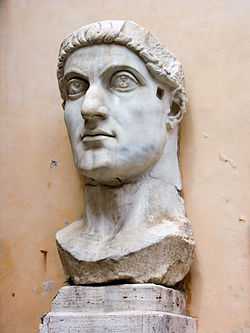Roman portraiture

Roman portraiture was one of the most significant periods in the development of portrait art. Originating from Ancient Rome, it continued for almost five centuries. Roman portraiture is characterised by unusual realism and the desire to convey images of nature in the high quality style often seen in Ancient Roman art. Some busts even seem to show clinical signs.[1] Several images and statues made in marble and bronze have survived in small numbers. Many Roman portraits are directly linked to specific individuals, such as gods and emperors.
Portrait sculpture from the Republican era tends to be somewhat more modest, realistic, and natural compared to early Imperial works. A typical work might be one like the standing figure “A Roman Patrician with Busts of His Ancestors” (c. 30 B.C.) [2]
By the imperial age, though they were often realistic depictions of human anatomy, portrait sculpture of Roman emperors were often used for propaganda purposes and included ideological messages in the pose, accoutrements, or costume of the figure. Since most emperors from Augustus on were deified, some images are somewhat idealized. The Romans also depicted warriors and heroic adventures, in the spirit of the Greeks who came before them.
Ideology
Religious functions and origins

The origin of the realism of Roman portraits may be, according to some scholars, because they evolved from wax death masks. These death masks were taken from bodies and kept in a home altar. Besides wax, masks were made from bronze, marble and terracotta. The molds for the masks were made directly from the deceased, giving historians an accurate representation of typically Roman features.
Politics
In the days of the Republic, full-size statues of political officials and military commanders were often erected in public places. Such an honor was provided by the decision of the Senate, usually in commemoration of victories, triumphs and political achievements. These portraits were usually accompanied by a dedicatory inscription. If the person who was commemorated with a portrait was found to have committed a crime, the portrait would be destroyed.
Social and Psychological aspect
Development of the Roman portrait was associated with increased interest in the individual, with the expansion of the social circle portrayed. At the heart of the artistic structure of many Roman portraits is the clear and rigorous transfer of unique features of the model, while still keeping the general style very similar. Unlike the ancient Greek portraits that strived for idealization (the Greeks believed that a good man must be beautiful), Roman portrait sculpture was far more natural and is still considered one of the most realistic samples of the genre in the history of art.
Historical development
Republican period
Imperial period
Roman portraiture of the Imperial period includes works created throughout the provinces, often combining Greek, Roman, and local traditions, as with the Fayum mummy portraits.
-

L. Calpurnius Piso Pontifex, late 1st century BC–early 1st century AD
-

Husband and wife from Pompeii, 20–30 AD (Portrait of Paquius Proculo)
-

Young woman with Flavian-era hairstyle, 80s–90s AD
-

Antinous, ca. 130 AD
-
_01.jpg)
Vibia Sabina, ca. 130 AD
-

Marcus Aurelius, ca. 161-180 AD. Walters Art Museum, Baltimore.
-

Mummy portrait from Roman Egypt, 2nd–3rd century AD
-

Colossus of Constantine, 312–315 AD
See also
- Imagines
References
| Wikimedia Commons has media related to Ancient Roman portraits. |
Bibliography
- (Italian) Ranuccio Bianchi Bandinelli, Il problema del ritratto, in L'arte classica, Editori Riuniti, Rome 1984.
- (Italian) Ranuccio Bianchi Bandinelli e Mario Torelli, L'arte dell'antichità classica, Etruria-Roma, Utet, Turin 1976.
- (Italian) Pierluigi De Vecchi & Elda Cerchiari, I tempi dell'arte, volume 1, Bompiani, Milan 1999